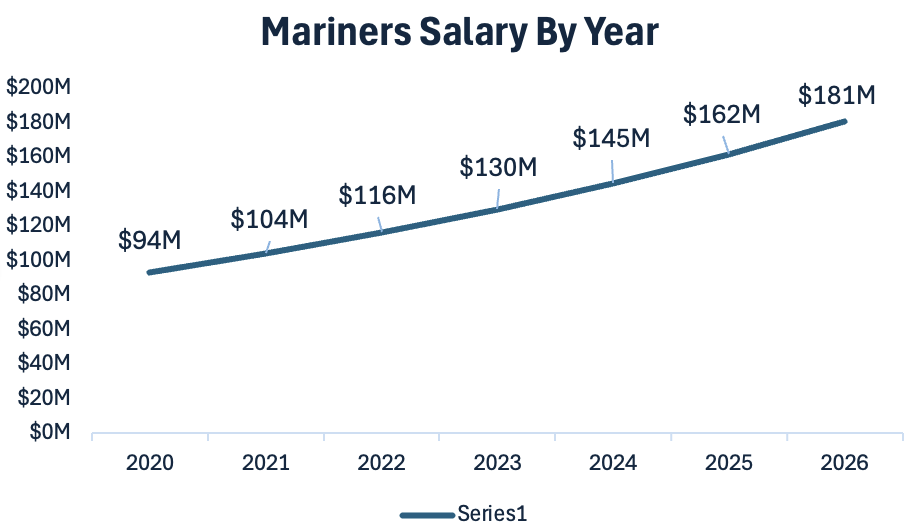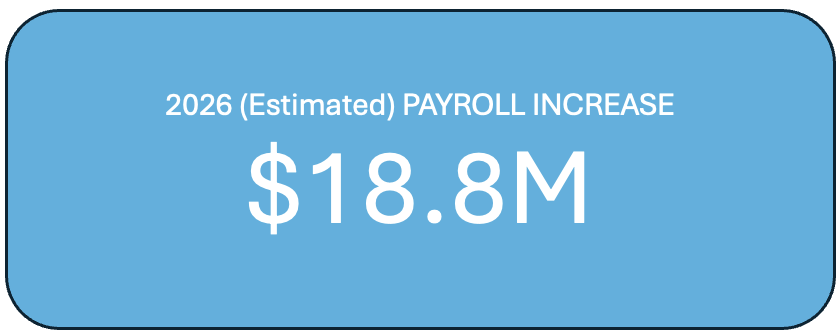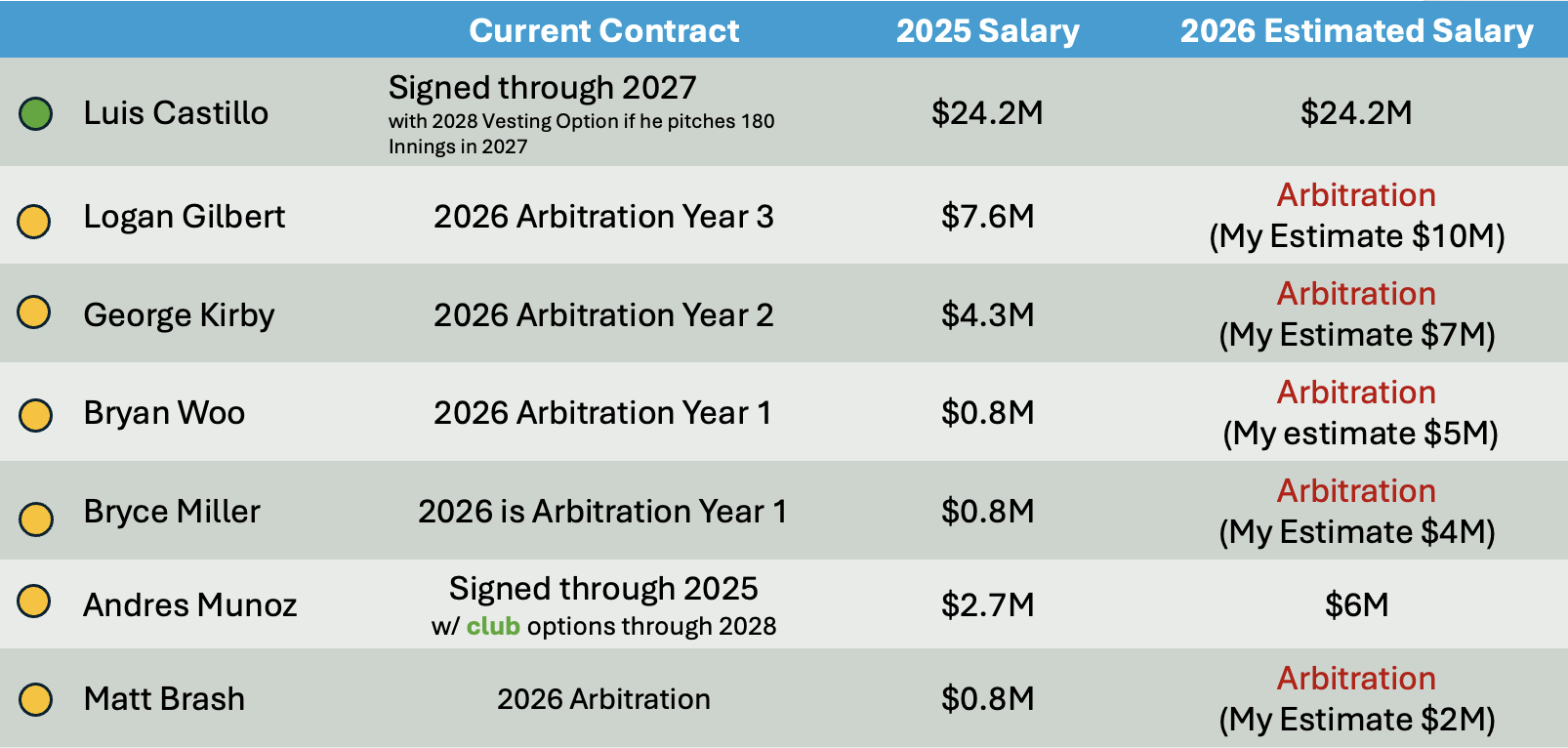Bring Back the Fire: Sign Josh Naylor Like We Did Castillo
in 2022, the Mariners signed Luis Castillo after he was traded from the Reds. Let’s examine if we should do the same for John Naylor, Eugenio Suarez, and/or Randy Arozarena.
Rally Cry to Sign Josh Naylor
In 2022, the Mariners made a statement—trading for Luis Castillo at the deadline, then locking him down with a five-year, $108M extension during the season. That move wasn’t just about pitching—it was about belief. Castillo had shown enough to earn a long-term spot in the rotation, and despite some ups and downs, he’s been a reliable anchor, especially at home (2.41 ERA at T-Mobile, 3.57 overall).
Here’s a quick breakdown of Castillo’s deal:
$7M signing bonus
$10M in 2023 (final arbitration year)
$22.75M annually from 2024–27
Full no-trade clause for the first 3 years
He stayed because of clubhouse chemistry. Dipoto called him “a dynamic power pitcher in his prime.” Seattle paid a steep prospect price—but they secured their guy.
Now, we’re at a similar crossroads.
Josh Naylor and Eugenio Suárez are both pending free agents. I’d love to keep both—but if we’re being realistic, 2026 payroll constraints and roster priorities may force a choice. And for me, that choice is clear: Josh Naylor must be the one we sign.
He hits for average, brings lefty power (30+ HRs in 2024), and could be locked in at a more affordable rate than Suárez. In this piece, I’ll break down why Naylor is the smarter long-term investment—and why the Mariners should act now, just like they did with Castillo.
What Opportunities are There to Improve the Roster?
There are three main opportunities to improve an MLB roster:
1) Farm System
This is the team’s minor league network, used to develop, evaluate, and prepare players for the big leagues. Players like Julio Rodriguez and Cal Raleigh came up through the Mariners’ system. The farm system is often the cheapest way to build a roster, since players are paid near league minimum until they reach arbitration eligibility. MLB teams can pay a player the league minimum during their first three years of Major League service time, though they can also pay more (Like Julio Rodriguez when he signed his contract during his Rookie Season).
2) Free Agency
When a player’s contract ends or they’re designated for assignment, they can become a free agent. Top-tier players test the market to find their value, and teams compete to sign them. The Mariners have historically been cautious in free agency, likely due to budget constraints. A recent example is Mitch Garver, signed after the 2023 season to a two-year, $24M deal.
3) Trade
A trade occurs when teams exchange player(s) for other player(s), draft picks, cash, or other considerations (yes, historically even a bucket of baseballs). Many key Mariners, including Luis Castillo, Randy Arozarena, Josh Naylor, and Eugenio Suarez, were acquired via trade over the past four seasons. Trades are a strategic way to improve the roster immediately without waiting for prospects to develop.
Market Dynamics
High-salary teams like the Yankees and Dodgers rely heavily on free agency and trades to assemble elite lineups. They can outbid smaller-market teams for top talent. The Mariners, by contrast, are more cautious about overpaying, and it can be challenging to attract position players to Seattle—especially right-handed hitters—due to budget limits and a ballpark that is not particularly hitter-friendly.
Mariners Payroll through the years
Over the last 5 years, the Mariners on average increase there payroll by 11.6% per year. Despite the Mariners being known to be frugal, we are spending big and John Stanton really is not getting the credit he deserves. Almost doubling the payroll in 5 years is quite a big jump.
2025 (Estimate): $161,807,328
2024: $147,930,632
2023: $124,766,903
2022: $110,826,407
2021: $83,822,113
2026 is estimated based on the YoY growth
In 2026, based on the 11.6% per year increase, we can anticipate the payroll jumping from $161.8M —> $180.6M. That is an additional $18.8M of spend, we have to work with in 2026
source: https://sports.betmgm.com/en/blog/mlb/seattle-mariners-payroll-bm23/
Open 2026 Budget for Players Already Released in 2025
Our $161.8M 2025 payroll includes players that have already been released on the team that the Mariners paid. Even though we likely paid most of Mitch Hanigers and Dylan Moore’s 2025 salaries, this opens up a lot of budget for 2026! Below are some of the released players from 2025 and their estimated 2025 payrolls:
1) Mitch Haniger: $15.5M
2) Dylan Moore: 3.9M
3) Leody Taveras: $3.7M
4) Rowdy Telez: $1.2M
Total Payroll of 4 released players: $24.3M
If you add the estimated 11.6% payroll increase AND add in the open budget due to release players in 2025, we should have roughly $43M of additional payroll budget in 2026. That seems like a lot, but consider most players on our current roster will need to be paid more in 2026. Let’s break that down.
Let’s Review the Team’s Current Contract Situations
I like to use a simple “stoplight system” to frame contract situations:
Green – Locked in. Players under contract or team control through at least 2027.
Yellow – Caution. Signed through 2026 or still in arbitration, but no long-term deal in place.
Red – Urgent. Contract expiring soon, decisions needed now.
Below are the Mariners Core Position Players Contract Situations:
Below are the Mariners Core Pitchers Contract Situations:
4 out of the 5 Mariners pitchers are either in or entering Arbitration, meaning their salaries are going up. if the mariners decide to keep their starting 5, their payroll might increase roughly $12.5M next season. In addition to our starters, we will be paying Andres Munoz an additional $3.3M in 2026 and Matt Brash may earn another $1.2M
Overall the core pitchers for the mariners may expect to see a total of $17M increases in salaries for 2026 vs 2025.
Green Light Players: +$12M; Year-over-Year (YoY)
Cal Raleigh’s is anticipated to be paid $11M more in 2026 vs 2025. in additon, Victor robles’ salary is going up $1M for a combined $12M for the two players. Julio’s contract is more consistent year over year. Overall, the players under contract long term are expected to have $12M more pay next season…. Meaning out of the potential $18.8M estimated payroll increase in 2026, we have only $6.6M remaining.
The Mariners do not need to worry much about any players who have a Long Term Contracts (Cal and Julio) because there contracts are already locked or players who are Pre-Aribitration or early career players such as Cole young, Ben Williamson, or Dominic Canzone. We are getting pre-arbitration players near league minimum for now, and then when we hit arbitration we still have the option to keep the player, but we would need to pay them the arbitration or agreed upon market value of the player.
Julio Rodriguez is an example of a pre-arbitration player we did sign long term, but those type of contracts during pre-arbitration are rare and often reserved for players that have only the highest ceiling.
Long Term Contracts (through 2027+):
Cal Raleigh, Julio Rodriguez, and Luis Castillo are signed long term, we do not have to worry about them for many years. I am also including Victor Robles in this category, who is signed through 2026 with a club option in 2027 (meaning the Mariners can decide to extend him that year), because the club controls his 2027 contract.
Pre-Arbitration
Cole Young for example is a rookie and is pre-Arbitration meaning we have control over his contract and can pay him league minimum for 3 seasons. Once arbitration hits, we still can keep him on the Mariners without worrying about free agency, but an “arbitrator” may decide on the value of the player which is usually significantly higher than league minimum. We have a long time before we have to worry about Cole Young or other rookies.
Dominic Canzone is also in pre-arbitration through the 2026 season. We essentially get Canzone for one more season at near league minimum before we are required to pay him a rate that is closer to market.
Yellow Light Players (Signed through 2026 or 2026 Arbitration) +$21M
Randy Arozarena (Estimated $15M in 2026): 2026 is Randy’s final arbitration year, and with Randy being an All-Star in 2025 and showing signs of pop and speed, it is likely we may need to pay quite a bit more than his $11.3M 2025 salary. I am not Jeff Passan, but if i were to estimate, I would think his 2026 arbitration salary might be closer to $15M. I think that’s a fair price to pay for such a caliber player who has hit 20/20 in five consecutive seasons. My concern is he would then become a free agent in 2027 if we don’t make a deal…. So let’s make a deal! I would happily offer Randy Arozarena a 4 year $60M deal.
we can expect to pay Randy at least $4M in 2026
JP Crawford: JP has been one of the most reliable Mariners for a long time, although I would be surprised the Mariners decide to extend him now. He is still set to earn $12M in 2026 ($1M increase in 2026)
Jorge Polanco: Jorge is in a very interesting situation. He has a vesting option pending how many ABs he has in 2025. If he gets 450 ABs, he will be paid $6M in 2026 (savings of -$1M in 2026). Right now he is projected at 451 ABs for the season, so who knows where he ends up? If he doesn’t hit the 450 ABs, the mariners have the option to move on and buyout his crontract for $750K or pay him $8M for 2026. Since he is projected at 451 ABs, I am going to assume his 2026 salary will be $6M, or savings of $1M year over year.
4 Starters (Kirby, Gilbert, Woo, and Miller AND Top Relievers (Munoz and Brash): If I were the Mariners, I would not cut or trade any of the Mariners 5 starters, Munoz or Brash. Keeping these core pitchers requires significant capital with a pay increase to the amount of $17M
After the “Yellow Light Players”, we have $10.1M additional salary to spend for the 2026 season remaining.
Red Light Players
Right now, the Mariners project to have only about $10.1M in additional payroll for 2026. If we try to keep all three Red Light players—Naylor, Suárez, and Garver—that number could balloon to $25M+ in added payroll compared to 2025. Why? In 2025 we are only paaying Suárez and Naylor for the final third of the season after their trades, but in 2026 we’d be on the hook for full-season salaries (if we sign them)— and likely higher ones under new contracts.
Right off the bat, I am going to say The Mariners will buyout Mitch Garver with the $1M buyout because he just has not performed to the $12M expectected salary he would have in 2026. That alone would free up an additional $11.5M, giving us a total of $22.1M of Payroll for potentially signing Geno or Naylor.
Short on Funds
$22.1M is not enough for signing either Josh Naylor or Eugenio Suarez, and not both. I would expect Josh Naylors salary for 2026 to be somewhere between $12.5-$15M range, while Eugenio Suarez may have a salary closer to $20M after this season where he is one of the league leaders in HRs and RBIs. My recomendation is to sign Josh Naylor, and here is why:
Josh Naylor: Josh Naylor is one of the best hitters in baseball, and from what we have seen he is a solid fielder too. He is left handed, which is great at T-Mobile because specifically right handed hitters have trouble with the batters eye. If I were to sign one player from our current roster to a contract, it would be josh Naylor. Naylor bats .282 for this season and has some pop, which helped the Mariners already win a couple of games since his trade.
The Mariners could really use an every day first baseman, who can hit for both average and power. He is on pace for roughly 20 HRs this year, but he has the potential for 30+ HR seasons like he did in 2024. How much? In 2025 he signed a 1-year $10.9M contract, so I would think that since he had another solid season he might fetch something between the $12.5-$15M range. If I were the Mariners, I would try to offer the 28 year old a 3 year-$40M contract ($13.3M), and that would be fair on both sides.
Assuming we land Naylor with a $13.3M/year contract, we would have $8.8M remaining in our potential 2026 budget.
Eugenio Suarez: If the Mariners had unlimited money, I would 100% sign Eugenio Suarez. He is one of the best power hitters in baseball and really does elevate our team offensively. Of the “Red Light Players”, he would be someone I consider signing, but understand if we pass on him.
Geno is one of Seattles most beloved players, as he absolutely rakes and has helped us compete in the playoffs in 2022. There are 3 main reasons why we may not see Eugenio Suarez get signed
1) His 2025 contract was $15M and he had a great season, and he likely can fetch upward of $20M in 2026 (Again My Estimate, not Jeff Passan’s), which is steep for a guy who has one of the highest strikeout rates in the MLB. Baseball has no salary cap, but the Mariners surely do… We tend to be a little better than league average for payroll, but we rarely fork out $20M contracts like the Yankees, Dodgers, or Mets.
2) He is right handed, and right handed hitters struggle at T-Mobile park. This is a mystery of some sorts, but statistically right handed hitters (bother Home and Away hitters), tend to struggle at T-Mobile Park. He already is in the 4th percentile in WHIFF % (Meaning he swings and misses a lot), and it is likely only worse at T-Mobile due to the batters eye.
3) Ben Williamson showed a lot of promise as a defender and professional hitter at 3B. Now, I do not think Ben Williamson is even a close replacement at this point in his career for Eugenio Suarez. Defensilvy, Ben Williamson might be one of the best in baseball, but his hitting is not nearly as productive as Geno who can hit 40+ HRs any given season.
Again, if we had unlimited salary cap, I would 100% want Geno on the roster. However, based on our analysis, we simply do not have the expected budget in 2026 for both Naylor and Suarez.
With the remaining $8.8M, perhaps the Mariners can use that toward signing a potential DH or 3B of the future. Or perhaps we can use that to sign one of our Starting Pitchers in Arbitration to a higher priced long term contract that would give us value in years to come.
FInal Thoughts
In 2022, the Mariners showed boldness by trading for Luis Castillo and quickly locking him up long-term—a move that solidified the rotation and sent a message that Seattle was serious about contending. Now, with Josh Naylor, Eugenio Suárez, and Randy Arozarena in similar “red light” contract situations, the front office faces another defining moment.
The math is clear: payroll flexibility for 2026 is limited, and while the Mariners can’t afford everyone, they can afford to be strategic. Between the options, Naylor stands out as the most cost-effective, lineup-balanced, and ballpark-friendly fit to anchor first base for years to come. Suárez’s bat is electric, but his rising price tag and right-handed profile at T-Mobile make him a tougher call. Arozarena remains intriguing, but he’s more of a medium-term conversation with arbitration still in play.
The Mariners don’t have to operate like the Yankees or Dodgers to build a winner—but they do have to pick their spots. Just as Castillo became the long-term anchor of the rotation, Seattle now has the opportunity to make Naylor that anchor for the lineup.
The question isn’t whether the Mariners can afford to sign everyone. It’s whether they can afford not to sign the right guy.
I used the below document for contract details:









